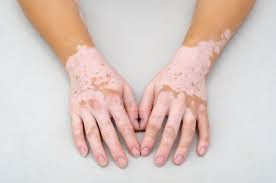Vitiligo:
Vitiligo is a condition in which uneven, small, or large white patches appear on the skin. It can affect any part of the body
 |
| Vitiligo |
Diagnosis of Vitiligo:
Visual Assessment Tests:
Vitiligo is diagnosed mostly by visually assessing the depigmented area.
Ultra Violet (UV) Light:
The healthcare provider observes the affected skin in the UV light. The skin affected with vitiligo appears blue..
Vitiligo Area Severity Index (VASI): The percentage of vitiligo affected skin is measured in hand units. The degree of pigmentation is calculated with this unit.
(1).100% – complete depigmentation in the observed patch.
(2).90% – presence of specks of pigment.
(3).50% – depigmented and pigmented area is equal.
(4).10% – small area of depigmentation
Skin Biopsy: A small sample of affected skin is scraped off and sent to laboratory for examination to confirm the diagnosis.
Treatment:-
Surgery:
If light therapy and medications haven't worked, some people with stable disease may be candidates for surgery. The following techniques are intended to even out skin tone by restoring color:
Skin grafting:
In this procedure, your doctor transfers very small sections of your healthy, pigmented skin to areas that have lost pigment. This procedure is sometimes used if you have small patches of vitiligo.
*Cellular suspension transplanttransplant:
In this procedure, your doctor takes some tissue on your pigmented skin, puts the cells into a solution and then transplants them onto the prepared affected area. The results of this repigmentation procedure start showing up within four weeks.
Therapies:-
Light therapy:
Phototherapy with narrow band ultraviolet B (UVB) has been shown to stop or slow the progression of active vitiligo. It might be more effective when used with corticosteroids or calcineurin inhibitors. You'll need therapy two to three times a week. It could take one to three months before you notice any change, and it could take six months or longer to get the full effect.
For people who can't go to a doctor's office for treatment, smaller portable or handheld devices for narrow band ultraviolet B therapy are available for home use. Talk with your doctor about this option as well if needed.
Drugs that control inflammationinflammation:
Applying a corticosteroid cream to affected skin might return color. This is most effective when vitiligo is still in its early stages. This type of cream is effective and easy to use, but you might not see changes in your skin's color for several months. Possible side effects include skin thinning or the appearance of streaks or lines on your skin.
Milder forms of the drug may be prescribed for children and for people who have large areas of discolored skin.
.Potential future treatments:
Treatments being studied include:
) A drug to stimulate color-producing cells (melanocytes). Called afamelanotide, this potential treatment is implanted under the skin to promote the growth of melanocytes.
) A drug that helps control melanoctyes. Prostaglandin E2 is being tested as a way to restore skin color in people with vitiligo that isn't widespread or spreading. It's applied to the skin as a gel.
Homemade Remides:
Protect your skin from the sun and artificial sources of UV light. Use a broad-spectrum, water-resistant sunscreen with an SPF of at least 30. Apply sunscreen generously and reapply every two hours — or more often if you're swimming or sweating.
You can also seek shade and wear clothing that shields your skin from the sun. Don't use tanning beds and sunlamps.
Protecting your skin from the sun helps prevent sunburn of the discolored skin. Sunscreen also minimizes tanning, which accentuates the vitiligo patches.
Conceal affected skin. Makeup and self-tanning products can help minimize the differences in skin color. You may need to try several brands of makeup or self-tanners to find one that blends well with your normal skin tone. The coloring of self-tanning products doesn't wash off, but it gradually fades over several days. If you use a self-tanner, select one that contains dihydroxyacetone, as it is approved by the U.S. Food and Drug Administration.
Don't get a tattoo. Damage to your skin, such as that caused by a tattoo, may cause a new patch of vitiligo to appear within two weeks.

